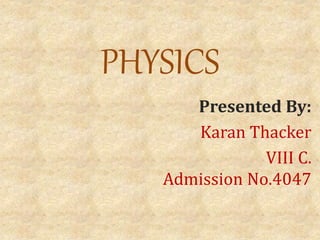
Physics howercraft
- 1. PHYSICS Presented By: Karan Thacker VIII C. Admission No.4047
- 2. TOPICS TO BE DISCUSSED:- 1) Introduction. 2) History. 3) Working Principle. 4) Uses in Various Field. 5) Images. 6) Difference with other airboats.
- 3. INTRODUCTION:- A hovercraft, also known as an air-cushion vehicle or ACV, is a craft capable of travelling over land, water, mud or ice and other surfaces. Hovercraft are hybrid vessels operated by a pilot as an aircraft rather than a captain as a marine vessel. Hovercraft use blowers to produce a large volume of air below the hull that is slightly above atmospheric pressure. The pressure difference between the higher pressure air below the hull and lower pressure ambient air above it produces lift, which causes the hull to float above the running surface. For stability reasons, the air is typically blown through slots or holes around the outside of a disk or oval shaped platform, giving most hovercraft a characteristic rounded-rectangle shape. Typically this cushion is contained within a flexible "skirt", which allows the vehicle to travel over small obstructions without damage.
- 4. HISTORY:- The first practical design for hovercraft derived from a British invention in the 1950s to 1960s. They are now used throughout the world as specialized transports in disaster relief, coastguard, military and survey applications as well as for sport or passenger service. Very large versions have been used to transport hundreds of people and vehicles across the English Channel, whilst others have military applications used to transport tanks, soldiers and large equipment in hostile environments and terrain. Although now a generic term for the type of craft, the name Hovercraft itself was a trademark owned by Saunders- Roe (later British Hovercraft Corporation (BHC), then Westland), hence other manufacturers' use of alternative names to describe the vehicles.
- 5. WORKING PRINCIPLES:- • Hovercraft float on a cushion of air that has been forced under the craft by a fan. This causes the craft to rise or lift. The amount of lift can range from 6" to 108" (152mm to 2,743mm) depending on the size of the craft. The amount of total weight that a hovercraft can raise is equal to cushion pressure multiplied by the area of the hovercraft. To make the craft function more efficiently, it is essential to limit the cushion air from escaping, so the air is contained by the use of what is called a skirt. Hovercraft skirts vary in style ranging from bags to cells (jupes) to separate fingered sections called segments. Most Neoteric hovercraft utilize the segmented skirt system because each segment can deflect individually when passing over bumps so that very little lift air is lost on uneven terrain.
- 6. Once "lifted" or "on cushion", thrust must be created to move the hovercraft forward. With many craft, this is generated by a separate engine from the one used to create the lift, but with some, the same engine is used for both. As the diagram above indicates, the fan-generated air stream is split so that part of the air is directed under the hull for lift, while most of it is used for thrust. Now that the hovercraft has lift and thrust, it must be steered safely. This is achieved through the use of a system of rudders behind the fan, controlled by handlebars up front. Steering can also be controlled by the use of body weight displacement
- 7. USES IN VARIOUS FIELD:- Exploring the vast number of shallow and narrow waterways that cannot be reached by boat . Rescue work on swift water, ice, snow, mud flats, deserts, wetlands, shallow water, swamps, bogs, marshes and floodwaters. Transport in environmentally sensitive areas where habitat, erosion and soil compaction are a concern . Military services. Dive recovery teams. Retrieving birds from tailings ponds at mining sites . Survey work. Forestation. Environmental testing Oil spill cleanup
- 8. IMAGES:-
- 9. DIFFERENce FROM OTHER AIR BOATS:- Hovercraft use less fuel, make less noise, are dynamically safer, are more maneuverable and versatile and are better at amphibious tasks than airboats. Hovercraft are flying machines that travel above the surface on a cushion of air. Airboats are simply flat-bottomed boats with a huge two- to six-bladed propeller; their entire weight planes across the surface like a ski. On water, airboats create a wake; hovercraft do not because they fly several inches above the water. Both are amphibious vehicles but the hovercraft, since it rides on a bubble of air, is better on dry terrain. Unlike hovercraft, airboats can’t operate very well over mud, sand, pavement, gravel, grass or other dry surfaces. The airboat’s flat hull is usually coated with plastic to reduce friction and help protect its hull when crossing such terrain. Airboats are even limited to fairly smooth water because their hulls contain minimum flotation and are easily swamped. The airboat’s tall propeller also limits its usefulness in areas with overhead obstructions, which are often found in flood conditions. The airboat’s propeller runs close to the speed of sound and generates twice the noise of a hovercraft. Airboats have a high thrust-to-weight ratio, close to 1:1, so airboat thrust is equal to gross weight. Hovercraft thrust is only 1/10 the gross weight. Since energy consumption is related to thrust, an airboat consumes two to three times more energy than a hovercraft, therefore uses more fuel.
